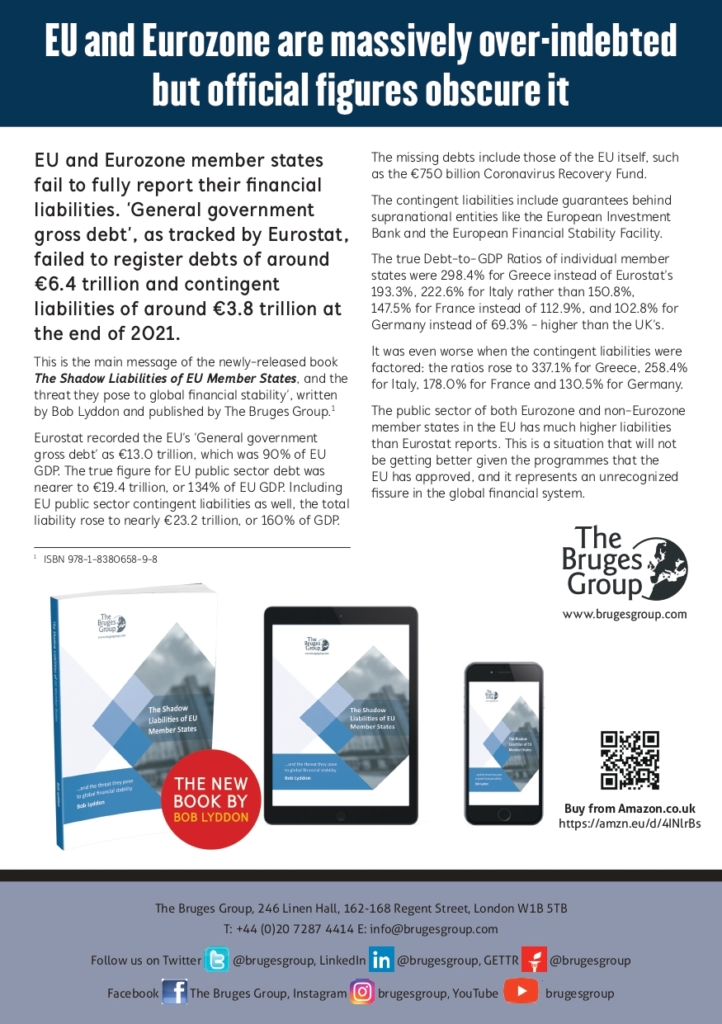Published on 12th April 2023
EU and Eurozone member states fail to fully report their financial liabilities. The key measure tracked by Eurostat – ‘General government gross debt’ – is circumvented to such an extent that, based on year-end 2021 figures, debts of around €6.4 trillion failed to be registered, and contingent liabilities of around €3.8 trillion.
This discrepancy is the main message of the newly-released book ‘The shadow liabilities of EU Member States, and the threat they pose to global financial stability’, written by Bob Lyddon and published by The Bruges Group.[1]
At year-end 2021 Eurostat recorded the EU’s ‘General government gross debt’ as €13.0 trillion, which was 90% of EU GDP of €14.5 trillion. EU public sector debt, including the shadow debts, was nearer to €19.4 trillion, or 134% of EU GDP. Including EU public sector contingent liabilities as well, the total liability rose to nearly €23.2 trillion, or 160% of GDP.
Eurostat’s Debt-to-GDP Ratio for the EU of 90% understated the situation by 44% if one takes account of the shadow debts, and by 70% if one factors in the shadow contingent liabilities as well.
The missing debts include those of the EU itself, such drawings under the €750 billion Coronavirus Recovery Fund, and those incurred by member state central banks within the TARGET2 payment system.
Contingent liabilities are in the main guarantees, such as to pay in extra capital to the European Investment Bank should it be required, or to recapitalize the European Central Bank should it make losses on its programmes, in the same way that the UK taxpayer is exposed for up to £133 billion, according to Reuters, for the Bank of England unwinding its Quantitative Easing.[2]
The additions mean that the Debt-to-GDP Ratios of individual member states were, for example, 298.4% in the case of Greece compared to Eurostat’s 193.3%. Italy’s was 222.6% rather than 150.8%. France’s rose from 112.9% to 147.5%. Germany’s was above the UK’s, going from 69.3% to 102.8%.
It was even worse when the contingent liabilities were factored in as well: Greece sat at 337.1%, Italy at 258.4%, France at 178.0% and Germany at 130.5%.
These figures do not reflect the worst-case for member states should one or more of their number default: member states cross-guarantee one another in a variety of ways, such that the liabilities of the stronger member states are open to escalation beyond 130.5% for Germany and 178.0% for France.
The euro currency is not just structurally weaker than it is made to appear,[3] but the public sector of both Eurozone and non-Eurozone member states in the EU has much higher liabilities than Eurostat reports. This is a situation that will not be getting better given the programmes that the EU has approved, and it represents an unrecognized fissure in the global financial system.
[1] ISBN 978-1-8380658-9-8
[2] https://www.reuters.com/world/uk/uk-taxpayers-hook-133-billion-pound-bill-cover-boe-losses-2022-11-17/ accessed on 18 November 2022
[3] B Reynolds, D Blake and R Lyddon, Managing Euro Risk: Saving Investors from Systemic Risk (Politeia, 2020)

